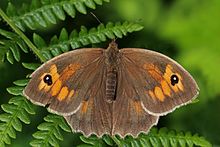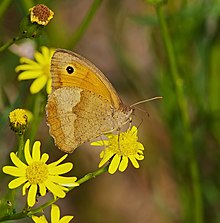Meadow brown
| Meadow brown | |
|---|---|
 |
|
 |
|
| Both females | |
| Scientific classification | |
| Kingdom: | Animalia |
| Phylum: | Arthropoda |
| Class: | Insecta |
| Order: | Lepidoptera |
| Family: | Nymphalidae |
| Genus: | Maniola |
| Species: | M. jurtina |
| Binomial name | |
|
Maniola jurtina (Linnaeus, 1758) |
|
The meadow brown (Maniola jurtina) is a butterfly found in the Palearctic realm. Its range includes Europe south of 62°N, Russia eastwards to the Urals, Asia Minor, Iraq, Iran, North Africa and the Canary Islands. The larvae feed on grasses.
There is marked sexual dimorphism in this species. Males are less colorful, with smaller eyespots and much reduced orange areas on the upper forewings. They are also much more active and range far about, while females fly less and often may not move away from the area where they grew up.
A variable number of smaller eyespots are usually found on the hindwing undersides. These may number up to twelve per butterfly, with up to six on each wing, but sometimes none. The factors that govern polymorphism in this trait are not resolved, although a number of theories have been proposed (Stevens 2005). On the other hand, the evolutionary significance of the upperwing eyespots is more obvious: The more active males have a markedly more cryptic upperside pattern, whereas the females have more opportunity to present their eyespots in a sudden display of colors and patterns that presumably startle predators so the butterfly has a better chance of escaping. Some specimens are bi-pupilled.
Small heath (for comparison)
Female
Female
Female
Mating
Mating
First instar caterpillar
Pupa
Similar species are the gatekeeper (which prefers to rest with its wings open) and the small heath (which is smaller). More similar are the dusky meadow brown (Hyponephele lycaon smaller, male androconial area obliquely directed and divided into three parts by veins Cu1 and Cu2, female with two ochreous ringed eye-spots) is otherwise very similar, Pyronia janiroides, Hyponephele moroccana, Hyponephele lycaon and Hyponephele lupina. Most problematic is the cryptic species complex of Maniola (Maniola telmessia, Maniola nurag, Maniola chia, Maniola halicarnassus and Maniola cypricola).
...
Wikipedia
